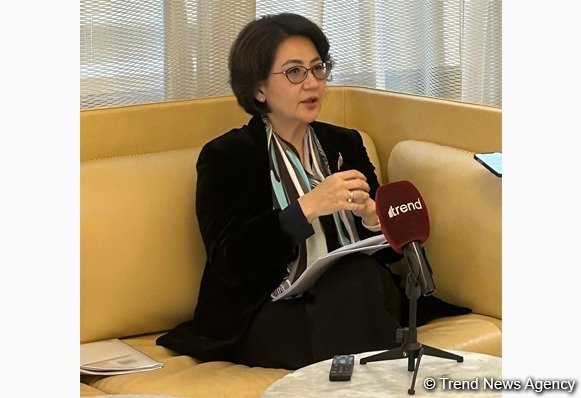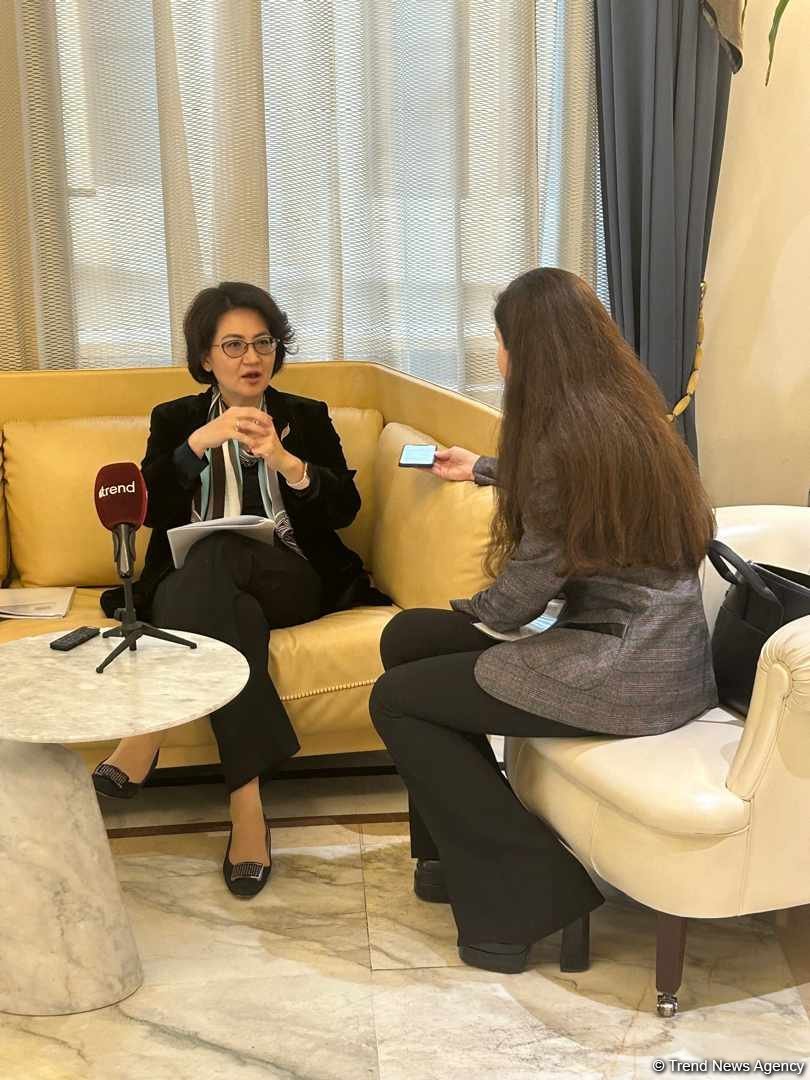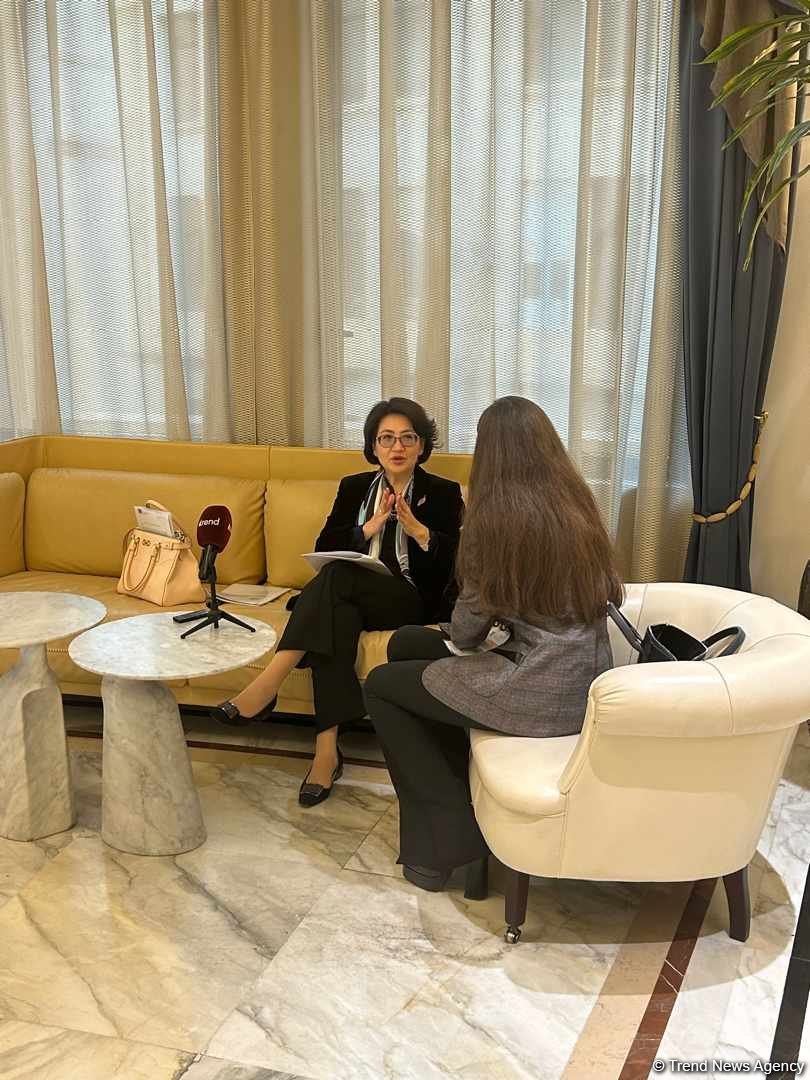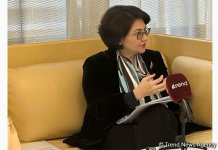BAKU, Azerbaijan, May 16. The Middle Corridor is important for diversification of trade and transport routes from China to Europe, Lyaziza Sabyrova, Regional Head, Regional Cooperation and Integration of the Asian Development Bank's (ADB) Central and West Asia Department (CWRD), said in an exclusive interview with Trend.
"The development of the Middle Corridor is emerging as a big agenda among many development partners. There are so many international forums, conferences, and even national gatherings discussing the Middle Corridor. The Middle Corridor—which is also referred to as Corridor 2 under the Central Asia Regional Economic Cooperation (CAREC) Program—offers the opportunity for diversification of transport and transit routes from China to Europe through Central Asia and South Caucasus countries, including Azerbaijan. Aside from the diversification of routes the Middle Corridor is also important for Central Asian countries, including the Kyrgyz Republic, as a mechanism or channel through which they can export their own products. For that, of course, such countries need to produce exportable goods, in turn encouraging more diversified production," she said.
Sabyrova pointed out that developing the Middle Corridor is not just about building roads, ports, or railway links, but combining hard infrastructure with soft infrastructure to ensure that the movement of goods and people across the borders is smooth and easy.
Sabyrova cited that Azerbaijan and Georgia are now working towards potential joint border crossing points.
"Actually, there are several ADB projects upgrading border crossing points. ADB is now looking at developing a joint border crossing point, where procedures for clearance from both Azerbaijani and Georgian sides can be done once and border crossing will be seamless. This can save a lot of time and effort for traders and business operators traveling between Azerbaijan and Georgia. It can be a very efficient system. We have tested this approach through a technical assistance introducing a joint customs manifest between China and Mongolia.
Another good example is our work in the Almaty-Bishkek Economic Corridor. We are working on the new border crossing point between Kazakhstan and the Kyrgyz Republic. I wanted to emphasize that hard and soft infrastructure development must go together. Because even with a perfect road or border infrastructure, if the procedures are cumbersome, it may take long hours for people or cars to cross a border, which will be inconvenient and costly," she explained.
Sabyrova also talked about the CAREC Corridor Performance Measurement and Monitoring mechanism.
"It's a long-term database where we collect actual data and measure how long it takes and how much it costs to cross a border. We regularly monitor whether there are improvements for movement of goods along the corridors. While there are notable improvements, there are routes that remain problematic. We are working with the private sector a lot, and with governments also to identify how we can address these bottlenecks.
Involving all stakeholders and country ownership along the Middle Corridor are crucial. If five Central Asian plus South Caucasus countries sit down with relevant international finance institutions, that is a good step. In ADB, we are very ready to support the initiative.
The Middle Corridor is a challenging route. It's a multi-modal corridor combining roads, railways, maritime, and ports. It remains expensive due to the bottlenecks I mentioned and relatively low traffic volumes. We need to generate economic activities and trade along the corridor, and that entails competition policy, diversifying the economy, and facilitating the overall economic growth of countries along the corridor," she said.
Supporting the Kyrgyz Republic's participation in CAREC
Lyaziza Sabyrova noted that the Kyrgyz Republic is a very important member of the CAREC Program.
"The Kyrgyz Republic is the next chair of the CAREC Program for 2025. For Kyrgyz Republic, regional cooperation is very important, because it's a relatively small economy with a small population. To get access to wider regional markets, Kyrgyz Republic should utilize any opportunity to expand, to connect to other countries, other consumers, and to attract investments. It’s very good that they are actively participating in the CAREC Program.
We do quite a lot for transport connectivity, with substantial investments in the transport sector. We also have energy investments. We are working closely with the government and other development partners to understand what the needs are, including on the mega project Kambarata-1. The project is of interest to international finance institutions for various reasons. First, it's a hydro project promoting renewable energy, it will help to move towards a greener economy, to reduce carbon emissions, Second, it’s a regional project: investing in this project will provide an electricity market for three CAREC members, particularly, Kazakhstan, the Kyrgyz Republic, and Uzbekistan", she added.
Sabyrova pointed out that the Kyrgyz Republic actively participates in trade facilitation measures to harmonize various procedures, including sanitary and phytosanitary measures within the CAREC Program.
"We're also working on agriculture and water resources, and education and labor skills, which are also very important for the Kyrgyz Republic. We are looking forward to developing further our connections and links under the CAREC Program," she added.
Technical assistance to Turkmenistan
She noted that Turkmenistan is another important country for ADB.
"For Turkmenistan, connectivity is very important, and the potential for this country is huge. We are also talking about health and needs in the social sector. Should the government be ready or interested in working with ADB to borrow for this type of needs, ADB is ready to provide investments.
We are also supporting Turkmenistan in preparing for its accession to the World Trade Organization which is important to link the country with the global economy. We also provided few grants for regional technical assistance, because they are part of the CAREC Program. Whenever we have any events related to agriculture, energy, transport, or trade, we always invite Turkmen officials. Last year, ADB enabled the sharing of experiences between Uzbekistan and Turkmenistan on energy issues," she explained.
Supporting Uzbekistan’s energy sustainability
She stated that ADB is now preparing a new Country Partnership Strategy for Uzbekistan.
"We hope it will be approved this year. This is a five-year strategy until 2028. The strategy aligns with the government priorities of Uzbekistan. It puts great focus on green transition. Uzbekistan’s government is very serious about green transition, as they understand its importance. They understand that they need to make good investments in green transition and formulate good policies. For now, the preparation of the Country Partnership Strategy is still ongoing. But the few emerging areas where we will be providing support for the next five years are precisely green transition, private sector development, human capital development, and competitiveness of the private sector," she said.
Sabyrova went on to add that gas is a major product of Uzbekistan.
"We are also looking at it regionally. Because whenever we talk about energy security, it's always a regional matter. In the past, we invested quite a lot in the energy sector of Uzbekistan. One of them is the Talimarjan power station project, which has been completed and had good results, including a reduction in carbon emissions. Uzbekistan is the second largest borrower in ADB’s Central and West Asia Department," she concluded.
Follow the author on X: @Lyaman_Zeyn













